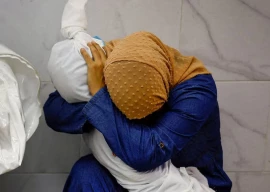
KARACHI: Conventional wisdom brackets artists as elitists, people least concerned with the issues that plague the common person. Inflation, domestic violence and living on the bare necessities do not worry them.
In reality, though, Pakistan’s artists pitch in whenever they can. And on Monday some of them joined hands to launch an exhibition “No honour in killing - making visible the buried truth” at the VM art gallery to show their joint reaction to the brutal murders of five women in Nasirabad.
The exhibition began its travels from Jamshoro and Khairpur, where the issue is prevalent. It then headed to Islamabad and Lahore, finally coming to Karachi.
“The concept of women as property, honour and reward is so deeply entrenched in the social, political and economic fabric of Pakistan that daring to defy the traditions in a ‘man’s world’ could lead to an atrocious ending,” said Marium Agha, one of the artists.
Interestingly, there was more dialogue at the exhibition. Instead of strolling past paintings in quiet observation, people raised their voices against the odious honour killings in Nasirabad and the artwork took a back seat.
Speakers ranged from poet Attiya Dawood and her stirring verses to a brave woman named Khadija who actually ventured to the site of the murders to investigate the incident. “Society now talks against rape, but a lot of people don’t consider honour killing to be wrong,” said Dawood.
“In the city we do not feel that it is our problem, but that horrific incident jolted me into action,” Niilofer Farrukh, the curator of the exhibition told The Express Tribune. “As a curator, I felt that it was my duty to create an opportunity for both known and undiscovered artists.” Kausar Khan, an activist, told the audience in his address how change has come about, even if it has not been as drastic a change as was hoped. She explained how the Nawabpur case in the 1980s - a woman was stripped and paraded in the street - barely created a ripple, the gang rape of Mukhtaran Mai raised voices across the globe and prompted investigations, whereas the recent killing of a girl in Swat had the whole nation in an uproar. “Before this, rapes wouldn’t even be reported, but now not only are parents reporting them, they are also going to court,” said Khan.
The artwork itself was incredibly diverse: vague pieces done in experimental media, contemporary art, photography and ceramics all in one room. Some, like Marium Agha’s “72 virgins for my suicide lover” warranted a second look and some intellectual delving.
Abdul Majeed Mangi, a Khairpur-based artist, made his message very clear — his piece was oil on canvas showing a woman running into a vortex, surrounded on all four sides with dogs, an axe and a gun.
Amin Guljee’s “sun-dried heads II’ sculpture was a depiction of his signature wreath, except this time he used plastic dolls heads encased in bronze to form the ring.
Simeen Farhat and Quin Mathew’s archival print was a rather controversial representation of women as nothing but hollow veils with garbled Arabic script. Sylvat Aziz also made use of veils in her work, whereas Mehr Afroze used muslin and ‘rang’ (coloured powder) to drive her point home.
“Today the world is polarised between two extremes,” she said. “The exploiters of tradition and religion are hell bent on imposing a medieval mindset on the population and those who consider morality and ethics redundant.”
Published in The Express Tribune December 8th, 2010.





























































COMMENTS
Comments are moderated and generally will be posted if they are on-topic and not abusive.
For more information, please see our Comments FAQ